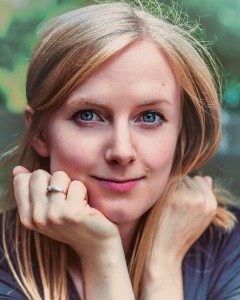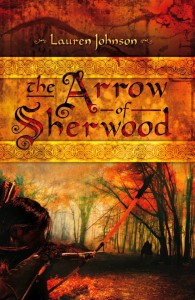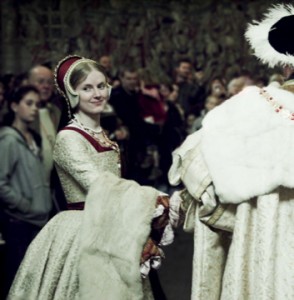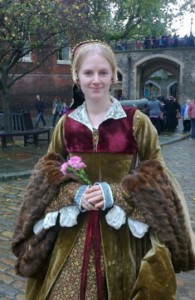Lauren Johnson is the author of ‘The Arrow of Sherwood.’ She also works as a research manager and costumed interpreter for Past Pleasures.
Follow Lauren Johnson on Social Media:
Lauren’s website: Lauren-Johnson.com
Twitter @History_Lauren
Facebook Lauren Johnson
Buy ‘Arrow of Sherwood’ from Amazon.co.uk
Many thanks to Lauren for answering my questions.
How did you get involved with live costumed historical interpretation?
I studied History at Oxford University and I’ve always loved investigating the past. But I particularly enjoy communicating with others about the past beyond just writing essays or conference papers for the academic world. During my time at university I was part of an improvised comedy group called the Oxford Imps, and it was through the improv grapevine that I heard about Past Pleasures – the company who do all the daily interpretation at Hampton Court Palace and the Tower of London. I applied to them and because I have a mix of performance and historical experience, got a job.
As Research Manager for Past Pleasures, part of your job is to produce research packs for the rest of the team. What does a research pack consist of?
A research pack provides an overview of the topic we are representing during an event – it could be ‘Jane Seymour’s pregnancy, queenship and the Pilgrimage of Grace’ or ‘Christmas in Edward I’s Court’. I do a range of primary and secondary source research and compile it into a useable pack for the team performing the event, offering an introduction and clear line of interpretation to match the director’s vision (eg. Jane Seymour wasn’t really as meek she’s popularly imagined), then the team goes away and they do their own independent research from there.
Are there any interesting facts that you found during your research that really helped your or the team’s interpretations?
I love the fact that history is constantly evolving, so what one generation of historians believes is questioned by the next – even without new sources coming to light, it’s sometimes just a matter of re-examining things and taking a different angle on the issue. So lots of the ‘facts’ I’ve found interesting are ones that challenge what I thought or was taught at school – like how Anne of Cleves was really ugly and Henry VIII composed Greensleeves, both of which have a kernel of truth (Henry didn’t fancy poor Anne and he did compose a lot of music) but aren’t necessarily true. When it comes to the Greys, I really enjoy how interpretations have changed, so at one time Lady Jane Grey was this slightly pathetic pawn figure but, while her story is still tragic, I think now we generally understand her as a religiously motivated young woman who was willing to die for her beliefs. Likewise, her mother wasn’t just a child-beating harridan, but a complex political figure in her own right.
Who has been your favourite historical person to play so far?
Probably Katherine Parr, who played an important part in Jane Grey’s life by acting as her guardian at Sudeley. She’s not remembered as being the most interesting Tudor – people tend to imagine some aged nursemaid when they think of her – but I think her life was incredibly exciting. Before she married Henry VIII she had already been married twice, and her second husband was forced into rebelling against the King in the Pilgrimage of Grace. While queen she was regent of England during Henry VIII’s wars with France; she dealt very astutely with an attempt by a conservative court faction to have her arrested for heresy in 1546; and I suspect that a large part of the reason that England became a Protestant nation was down to her influence as stepmother to Prince Edward and Princess Elizabeth. There is a lot to admire about her.
Who would you like to portray?
I’d love to interpret Henry VIII’s sisters, Mary and Margaret. I’ve played Mary once, but never Margaret. They were both absolutely fascinating individuals and, like Henry, expected to have real romantic lives and not just arranged marriages, which got them in trouble. Mary remarried Henry’s best friend while she was still supposed to be in mourning for her first husband, the French King. And Margaret was first married when she was fourteen (to the King of Scotland) and later had a very tempestuous relationship with her second husband, the Earl of Angus. They were both very strong-willed. I bet they were a match for their brother.
Do you have a favourite location that you have worked at?
I love all the locations I regularly work in for different reasons. Dover Castle has an incredible, vibrant reconstruction of a twelfth century palace and is amazing for story-telling; Audley End House – where I represent a scullery maid in the service wing – enables the visitor to wander through the machinery of ‘downstairs’ life and help with the washing up! And Hampton Court Palace and the Tower of London have the most astonishing histories – it is amazing to be in buildings that saw the events we are interpreting when they happened for real.
What is the best question you have been asked while in costume?
I love it when you do a presentation about someone relatively unknown and leave the story hanging because you’re ‘in 1540’ or whatever it might be. If you get people coming up at the end to hear how the story really finished, that’s always great because it means they have become invested in that person’s life and want to know more about it. So it’s a bit of a boring answer but any question is great, because it means the person asking has been inspired to know more.
What did your portrayals of Jane, Katherine and Frances Grey involve? Where were they set? What research did you do for the roles? Who was your favourite Grey to play?
I have played four different members of the Brandon/ Grey family: Mary Tudor/ Brandon, Frances Brandon/ Grey and Ladies Jane and Katherine Grey. Leanda de Lisle wrote a great book about the Grey sisters which has been extremely useful to me, as have the biographies of Mary Tudor and Jane Grey by Eric Ives, Walter Richardson and Maria Perry. I’m looking forward to getting stuck into Leanda de Lisle’s new book about the Tudors over the Christmas break too!
It is surprisingly easy to read primary source material, thanks to British History Online, which has Henry Machyn’s diary (he was a Londoner writing at the time of Jane’s accession and imprisonment), and calendars of state papers and other contemporary records. I find that a really valuable resource.
I interpret Katherine as part of an education session at the Tower of London about the treatment of prisoners, because she is the exact opposite of what most people imagine of a Tudor prisoner. Elizabeth had her arrested for marrying and having a son without royal permission, which most students tend to see as a bit harsh, but she lived in comparative comfort, with servants, pets, and her son. Her imprisonment also reminds us that the Tudor succession was dicey right from the beginning of Elizabeth’s reign. I wonder what would have happened if she had accepted Katherine and her sons as her successors, rather than ostracized them…
The event about Jane Grey was also, unsurprisingly, at the Tower of London. It dealt with her brief time as queen and her execution. I have enormous respect for how she handled herself and there is no doubt in my mind that she was willing to die because of her religion. She is often imagined as being a victim, virtually a child forced to be queen by her horrible family, but I think that denies a lot of what she herself wrote and proclaimed. However, it is hard to deny that her story is tragic. We re-enacted part of her execution and taking one last look at the White Tower and blue sky from a scaffold before a blindfold was put over my eyes was an extremely eerie sensation. I got goose-bumps every time.
I have played Frances on a number of occasions at Hampton Court Palace, sometimes with a husband – Frances has a reputation for being a schemer while Henry Grey is often considered an idiot, but they seem to have been a good partnership in real life. I tend to use her as a way of unpacking women’s situations generally in that period, because despite her royal blood she is a very representative example of a lady at court. By playing her I can discuss attitudes to arranged marriage, children (the fact she only had daughters with Henry, for instance), status, the royal family, education, social position and faction, religion… She is a phenomenally useful character to interpret.
So far, I’ve only interpreted Mary Tudor/ Brandon once, but I would love to play her again – it was a half-hour presentation at Hampton Court about Mary’s illicit marriage to Charles Brandon and how it had landed her in hot water with Henry. A lot like her granddaughter, Katherine Grey, in fact! I loved raging loudly about my pig-headed brother Henry. Mary is one of the only women in Henry’s life who defied him and got away with it.
I enjoyed playing all of the family – perhaps Mary most of all – but it is the experience of interpreting Jane while standing a matter of yards from where she was executed that has stayed with me.
What does your new novel, The Arrow of Sherwood, add to existing works of fiction about Robin Hood?
I hope it roots the myth of Robin Hood – with all the derring-do and adventure you want from that story – in the historical world of the twelfth century. I always love works of both history and fiction that transport me to a 360-degree world, where the characters’ behaviour makes sense because of the expectations and ideas of their time and place.
I wanted to make my characters as realistic and empathetic as possible by creating an understandable and immersive medieval world, so that you can see why Robin might turn to lawlessness because of the injustices of the contemporary system, where the Sheriff of Nottingham can be simultaneously self-serving and sympathetic, and with a Maid Marian who’s neither a damsel in distress nor a proto-feminist asskicker.
Have you ever or would you like to represent a historical figure from the reign of Richard I?
I have played Richard’s one-time fiancée, Alice Capet, at Dover Castle. She is very interesting to interpret because we don’t know an enormous amount about her – although, rather luckily, when we first started playing her I came across a historian who was doing her PhD on Alice and her family, who provided us with some great research. But we do know that she was engaged to Richard for years without ever marrying him, which is rather curious, and there were rumours that she had had an affair – possibly even children – with his father, Henry II. Whether that is true or not, she is the classic example of a woman whose value was entirely measured by her inheritance – she was endowed with a crucial stretch of land between the Norman lands of Henry and the French lands of her father, King Louis. So as long as Henry held onto her he controlled that land. She was used as a pawn in the disputes between Henry and Richard on the one hand, and the French kings on the other, for decades. She was even imprisoned in a Norman castle. Eventually she was quietly married off to a regional lord, which suggests that the rumours about her suspect romantic life could have been true.
I would love to play Eleanor of Aquitaine. However, by Richard’s reign she’s in her seventies, so I’ll need to wait a while! But it’s good to know that even decades into the future there is a strong, fascinating female character I could interpret.








































